In Which What Does Not Include a Painting of a Whale is In Fact the Memory of the Story of a Whale
CATALOG ESSAY FOR SUSANNA BLUHM’S SOLO EXHIBITION, THE MONKEY ROPE, AT J. RINEHART GALLERY, SEATTLE, JULY 2021
What follows is an essay that was originally printed in a beautiful hardbound coffee table book published by J. Rinehart Gallery in Seattle, Washington. This publication features full-page full color images of the artwork in Susanna Bluhm's solo exhibition, The Monkey Rope, for which this essay was written. You can purchase your copy here!
BEAUTY
I am gazing at a lush, vibrant painting of a beach. A variety of objects are strewn across the purple, pink, yellow, and blue sand; illuminated in an almost blinding refraction. The sky is a brilliant blue interrupted by vaporous clouds. Ahead, each cresting wave glows green and agate-like beneath bright foam, and beyond them the sea is painted in darkened jewel tones. I feel I’m either in the moment right before something is about to happen; or that it has happened already. The scene is calm, even soothing. But something else lies beneath the surface of this assumed, tranquil beauty.
THE SUBLIME
In his treatise, A Philosophical Enquiry into the Origin of Our Ideas of the Sublime and Beautiful, 18th century Irish philosopher Edmund Burke made a distinction between beauty and the sublime. Burke’s notions of beauty ultimately relate to perceptions of possessive form—aesthetically pleasing and delectable; diminutive. Beauty inspires a quality of love or passion through a controlled enjoyment of tempered, and temperate, pleasures. Beauty is pleasing without threat. The sublime, on the other hand, provokes excitement explicitly through the pain or anxiety of threat. The vastness of the threat we behold is so large as to become incomprehensible. Though beautiful, this beauty cannot be controlled or possessed, creating tension or torment. The pleasure we derive from such torments comes not from experiencing them, but from a controlled distance through which we may perceive them. But in this state of bemused analysis we are only intellectually dislodged. To me, this seems like an opportunity to examine the sublime through a premise of re-embodiment and forced rooting, or rootedness, to describe these senses beyond the theoretical.
The painted beach I described is Susanna Bluhm’s At the Beach (The Pequod Meets the Virgin). What I feel is the simultaneity of both security and unease. The beach is safe. The sea is not. Through my experience of this tension, I understand my relationship to this memory of place but also to beauty, pleasure, mortality, and humanity. The items cast across the sand represent both the people and the narrator of this story. But they represent the viewer, too—we’re neither alone, nor in the midst of some cataclysm. It’s calm and beautiful. We don’t necessarily belong here, yet we’re here nonetheless. In this small scene is a sense of intimacy, and within that, a great internal, emotional vastness of longing. Through tethering beauty, vastness, and intimacy at this literal precipice, Susanna has queered and thus reframed the sublime.
The painted beach I described is Susanna Bluhm’s At the Beach (The Pequod Meets the Virgin). What I feel is the simultaneity of both security and unease. The beach is safe. The sea is not. Through my experience of this tension, I understand my relationship to this memory of place but also to beauty, pleasure, mortality, and humanity. The items cast across the sand represent both the people and the narrator of this story. But they represent the viewer, too—we’re neither alone, nor in the midst of some cataclysm. It’s calm and beautiful. We don’t necessarily belong here, yet we’re here nonetheless. In this small scene is a sense of intimacy, and within that, a great internal, emotional vastness of longing. Through tethering beauty, vastness, and intimacy at this literal precipice, Susanna has queered and thus reframed the sublime.
MEMORY
Susanna Bluhm’s series, Red Country, begins in 2017 after the 45th President’s inauguration. Through this project, she sought ways to personally experience what kind of country lies within the broader, non-coastal United States. Bluhm describes the purpose for this series as a dynamic opportunity to not hate her country through the action of getting to know it better. She says it is working. What interests me is why it works, the ways it shortens a chasm, and how this is transmitted through her paintings to us.
This series of paintings evokes my own potent memories of crossing vast stretches of the continent. I recall moments that were simultaneously communal, cinematic, loud, or profound; and lonely, quiet, intimate, and small. In many cases, Susanna’s paintings point gently, unassumingly, at the latter of these. Gazing through her painterly expression, we experience a sense of what Americana feels like, sensorily, through these quiet memories. People, and Susanna, are primarily present through the objects they leave, or in the atmosphere of the space itself. We’re invited to encounter moments between—here, in this library someone left a stool in the stacks and books strewn on the floor as if in the middle of reading. There, a backpack is laying on the floor and warm lights shine upon a studio wall where we’ve paused mid-conversation. Within each of these seemingly small moments are the sensations of a kind of vastness; the inability to perceive all that has happened or is happening; an unknowable distance, and depth. The beach, and the sea.
The humanness conveyed through these still scenes gives them significance, gravity, and meaning. And in fact, they are important to the people Susanna met, who guided her journey, telling her where to go. These locations were as beautiful as a seaside beach, as ordinary as the children’s section of a library, or as deeply historical as the location of Michael Brown’s murder in Ferguson, where Susanna met John and they bonded in a moment of being present, together.
This painting, The Spot in Ferguson where Michael Brown Lived and was Murdered by Police, and Where I Met John (Of Whales in Paint; in Teeth; in Wood; in Sheet-Iron; in Stone; in Mountains; in Stars), beautifully embodies Susanna’s characteristic style of storytelling and the vast lexicon of personal symbols that appear throughout all her work. Weighted to the right, the trunk of a large tree serves as a grounding figure. Its full height extends beyond our view, but its boughs cascade to the left over the rest of the scene. Though it moves opposite of the way we would normally read, it doesn’t feel threatening. The tree is a sheltering, watchful presence. A small hose extends from the foot of the tree, leaking onto the grass. A bouquet of flowers, and the plaque that memorializes Michael Brown, are lovingly painted in the center of the piece. The road stretches out into the distance, into the neighborhood beyond. A large mouth with teeth yawns across the lower half of the painting, decorated with abstract patterns and symbols, some of which are mirrored in the sky above. An eye appears to be present in the tree. We are all here together, collectively watching, waiting, and observing. We are participants, and we will not come out of this unaffected.
Mouths, eyes, hoses, and other symbols appear throughout Susanna’s work as indications of her presence. They may also represent complex states of awareness, observation, burdens, vulnerability, love, humanity; or even ecstatic pleasure and overwhelming affection. These insertions of human experiences speak to the embodiment of the participant in place and time, locating them--rooting us like that tree—inescapably in the moment as both a subject to events, and an actor in them. This implication subverts the passivity of a sublime experience from something that happens to us, towards something we are dynamically and actively engaged in. We are motivators of sublimity without distance.
The tension between humans and the sublime and this occurrence of both being an actor and a subject is not described anywhere better than in the novel Moby Dick. Susanna uses the titles of its chapters as a device to indicate a story beneath the story as an allegory and a portrait. Why Moby Dick? Why this story? Is it because of the unspoken connection between the whale and the man, that they require each other to explain, fulfill, or otherwise justify themselves in some mystical balance? Or is it the device of the sublime narrative, as told through Ishmael’s memory?
This series of paintings evokes my own potent memories of crossing vast stretches of the continent. I recall moments that were simultaneously communal, cinematic, loud, or profound; and lonely, quiet, intimate, and small. In many cases, Susanna’s paintings point gently, unassumingly, at the latter of these. Gazing through her painterly expression, we experience a sense of what Americana feels like, sensorily, through these quiet memories. People, and Susanna, are primarily present through the objects they leave, or in the atmosphere of the space itself. We’re invited to encounter moments between—here, in this library someone left a stool in the stacks and books strewn on the floor as if in the middle of reading. There, a backpack is laying on the floor and warm lights shine upon a studio wall where we’ve paused mid-conversation. Within each of these seemingly small moments are the sensations of a kind of vastness; the inability to perceive all that has happened or is happening; an unknowable distance, and depth. The beach, and the sea.
The humanness conveyed through these still scenes gives them significance, gravity, and meaning. And in fact, they are important to the people Susanna met, who guided her journey, telling her where to go. These locations were as beautiful as a seaside beach, as ordinary as the children’s section of a library, or as deeply historical as the location of Michael Brown’s murder in Ferguson, where Susanna met John and they bonded in a moment of being present, together.
This painting, The Spot in Ferguson where Michael Brown Lived and was Murdered by Police, and Where I Met John (Of Whales in Paint; in Teeth; in Wood; in Sheet-Iron; in Stone; in Mountains; in Stars), beautifully embodies Susanna’s characteristic style of storytelling and the vast lexicon of personal symbols that appear throughout all her work. Weighted to the right, the trunk of a large tree serves as a grounding figure. Its full height extends beyond our view, but its boughs cascade to the left over the rest of the scene. Though it moves opposite of the way we would normally read, it doesn’t feel threatening. The tree is a sheltering, watchful presence. A small hose extends from the foot of the tree, leaking onto the grass. A bouquet of flowers, and the plaque that memorializes Michael Brown, are lovingly painted in the center of the piece. The road stretches out into the distance, into the neighborhood beyond. A large mouth with teeth yawns across the lower half of the painting, decorated with abstract patterns and symbols, some of which are mirrored in the sky above. An eye appears to be present in the tree. We are all here together, collectively watching, waiting, and observing. We are participants, and we will not come out of this unaffected.
Mouths, eyes, hoses, and other symbols appear throughout Susanna’s work as indications of her presence. They may also represent complex states of awareness, observation, burdens, vulnerability, love, humanity; or even ecstatic pleasure and overwhelming affection. These insertions of human experiences speak to the embodiment of the participant in place and time, locating them--rooting us like that tree—inescapably in the moment as both a subject to events, and an actor in them. This implication subverts the passivity of a sublime experience from something that happens to us, towards something we are dynamically and actively engaged in. We are motivators of sublimity without distance.
The tension between humans and the sublime and this occurrence of both being an actor and a subject is not described anywhere better than in the novel Moby Dick. Susanna uses the titles of its chapters as a device to indicate a story beneath the story as an allegory and a portrait. Why Moby Dick? Why this story? Is it because of the unspoken connection between the whale and the man, that they require each other to explain, fulfill, or otherwise justify themselves in some mystical balance? Or is it the device of the sublime narrative, as told through Ishmael’s memory?
NATURE
One poignant feature of Moby Dick is in how it presents the sublime in a dynamic, characteristically masculine, way. Melville’s story suggests the positionality of humans as participants or actors of natural forces, while being subject to forces of nature greater than ourselves; and the effect this duality has upon our ego or our humility. He illustrates these concepts through the triad formed between Ishmael, Ahab, and Moby Dick. Each are interlinked, inseparable participants in their fate, dependent upon each other. Ahab’s existence is affirmed and validated by his obsession with the whale, almost in such a way as if one of them dies the other ceases to exist. Does Moby Dick survive that final plunge to the depths, pulling Ahab behind him to presumably drown? We don’t know. But ultimately the entire crew of the Pequod is lost, leaving only Ishmael, who has now shifted from a dispassionate and bemused observer to a fully present and invested participant. He, and by virtue of his narrative we, are no longer able to remain objective or passive. Ishmael must remain to tell the story to the rest of humanity. Had he not, both Ahab and Moby Dick, entwined in their sublime codependency, would have faded from memory and ceased to exist.
Susanna is in hot pursuit. Like both Ahab and Ishmael, she begins with an idea not knowing exactly what she’ll find, but knowing what she wants to recover. In the role of both pursuer and observer, she speaks to the ways in which traveling to these locations sometimes invoked a sense of negotiating herself into a space she felt outside of. She relates this sense of self to Ishmael who, at the beginning of the story, is introduced as an apathetic joiner believing those in whaling are beyond hope. But his curiosity overwhelms him nonetheless. He is a flaneur at sea. Differently from Ishmael, Susanna is highly curious but also invested, and hopeful about who and what she will encounter. She is aware of her positionality as an artist, and her Pacific-Northwesterliness, whiteness, class, gender, motherhood, and queerness. She represents her self-awareness through small clues such as the lumpy blue sack, representing all the parts of herself and everything she carries. While she does initiate the journey, in asking others to guide her, she slips into the position of a participant. In this way she motivates an embodied experience, rather than intellectual analysis, to become a part of the story rather than simply telling it. But even further, she becomes a narrator of collective memory, so that these things may not cease to exist.
Susanna is in hot pursuit. Like both Ahab and Ishmael, she begins with an idea not knowing exactly what she’ll find, but knowing what she wants to recover. In the role of both pursuer and observer, she speaks to the ways in which traveling to these locations sometimes invoked a sense of negotiating herself into a space she felt outside of. She relates this sense of self to Ishmael who, at the beginning of the story, is introduced as an apathetic joiner believing those in whaling are beyond hope. But his curiosity overwhelms him nonetheless. He is a flaneur at sea. Differently from Ishmael, Susanna is highly curious but also invested, and hopeful about who and what she will encounter. She is aware of her positionality as an artist, and her Pacific-Northwesterliness, whiteness, class, gender, motherhood, and queerness. She represents her self-awareness through small clues such as the lumpy blue sack, representing all the parts of herself and everything she carries. While she does initiate the journey, in asking others to guide her, she slips into the position of a participant. In this way she motivates an embodied experience, rather than intellectual analysis, to become a part of the story rather than simply telling it. But even further, she becomes a narrator of collective memory, so that these things may not cease to exist.
THE SUBVERSIVENESS OF QUEER SUBLIMITY
This is a marked difference in Susanna’s approach to the sublime, and the way the sublime has been previously handled. The historical sublime reflects the deep influence of colonial capitalist mythologies that sever humans from nature, forming a chasm. Nature, as an Othered entity, disrupts humanity’s idea of belonging or place within it. The sublime occurs because we become fearful that we are unnecessary. We’re confronted with our mortality at the prospect that nature endures, beyond us, without us, irrespective of us; a colonial, patriarchal, and disconnected reaction. In an attempt to control and subdue this fear, we create a false reassurance of safety through the illusion of order and hierarchy.
Susanna’s lens as a queer woman in the United States subverts this illusion. Rather than severance, the sublimity in these paintings is an immersion, an awareness of smallness and the assertion of vulnerability. Neither queerness, nor smallness, carries any assurances of safety. But to be present in spite of it, is key. Immersion is queer. Vulnerability and rough edges are queer. We are fully here, in a question; that is queer. Queerness is an angle, an adjacency, a parallel, or a polarity. Queerness is the space between lines.
This inherent, underlying backstory illustrates a tethering of nature to humanity. Though she may feel she doesn’t belong there, Susanna is still a part of these landscapes; her insertion of self and symbols into these spaces shortens the chasm between them. There is no hierarchy or figure onto which we can project our sense of sublimity; we cannot disconnect. We are actors, participants, motivators, and catalysts in nature. We are there alongside these forces, continuously shaping, and shaped by them. Susanna’s inherent subversion in painting the things she lives conveys this existence of simultaneity to be embodied, if only for a moment, by the viewer.
Susanna’s lens as a queer woman in the United States subverts this illusion. Rather than severance, the sublimity in these paintings is an immersion, an awareness of smallness and the assertion of vulnerability. Neither queerness, nor smallness, carries any assurances of safety. But to be present in spite of it, is key. Immersion is queer. Vulnerability and rough edges are queer. We are fully here, in a question; that is queer. Queerness is an angle, an adjacency, a parallel, or a polarity. Queerness is the space between lines.
This inherent, underlying backstory illustrates a tethering of nature to humanity. Though she may feel she doesn’t belong there, Susanna is still a part of these landscapes; her insertion of self and symbols into these spaces shortens the chasm between them. There is no hierarchy or figure onto which we can project our sense of sublimity; we cannot disconnect. We are actors, participants, motivators, and catalysts in nature. We are there alongside these forces, continuously shaping, and shaped by them. Susanna’s inherent subversion in painting the things she lives conveys this existence of simultaneity to be embodied, if only for a moment, by the viewer.
A COLLECTIVE STORYTELLING
Perhaps Susanna’s work is not about being or feeling safe but confronting the things we wish to protect ourselves from, the circumstances or perspectives that present themselves as the precipice; the divisive chasm. Queer sublimity subverts smallness, and severance, by expanding our collective awareness to uncover what has been overlooked, to give voice to what has been silenced, in this collaborative and shared story. Susanna’s work defines a place where she is confronting the cultural and philosophical differences that provoked these cross-country journeys in the first place. Rather than approaching the sublime from a distance, Red Country allows the undercurrent of discomfort and self-consciousness to occur while locating us within each story. She inspires our sense of curiosity, breaking apart the multifaceted nature of these implied nuances. She renders the precipice in beauty, beautifully; lovingly painting both the interiority of experience while placing herself and us materially into space. And so we are there with her in forming these stories, across time, threading this collaboration throughout the entirety of the series in ways that acknowledge the characters, the memory, the narrator, and the viewer. We are standing on the beach, rooted, facing the vastness and the beauty of the sea and this precipice, together. Where there was a chasm, there is now a space between lines.




